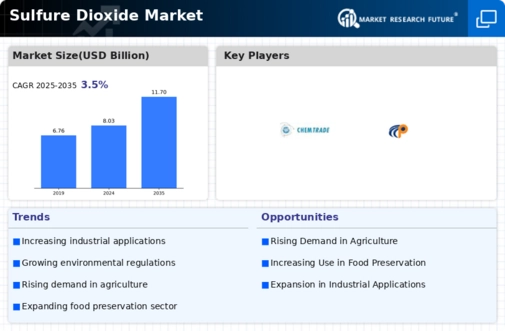Market Share
Sulfur Dioxide Market Share Analysis
In the Sulfur Dioxide market, companies employ various strategies to position themselves effectively and capture market share. One primary strategy is product differentiation. Companies focus on offering sulfur dioxide with unique features such as purity levels, concentration, or specific applications in industries like food preservation, water treatment, or chemical manufacturing. By highlighting these distinctive qualities, companies can attract customers seeking specialized solutions and gain a competitive edge, thereby securing a portion of the market share.
Cost leadership is another crucial strategy utilized in the Sulfur Dioxide market. Companies strive to produce sulfur dioxide at a lower cost compared to competitors while maintaining quality standards. This enables them to offer competitive pricing, appealing to cost-conscious customers and gaining market share. Cost leadership strategies often involve optimizing production processes, sourcing raw materials efficiently, and leveraging economies of scale to reduce manufacturing costs. By providing cost-effective solutions without compromising quality, companies can broaden their customer base and increase their market share.
Market segmentation plays a significant role in market share positioning within the Sulfur Dioxide industry. Companies segment the market based on factors such as application areas (e.g., food processing, mining, pulp and paper), end-user industries, or geographic regions. By understanding the unique needs and preferences of each segment, companies can tailor their products, services, and marketing strategies to better serve targeted customer groups. This targeted approach enables companies to penetrate specific market niches more effectively and gain market share within those segments.
Strategic partnerships and alliances are also crucial for market share positioning in the Sulfur Dioxide market. Collaborating with other companies, sulfur dioxide producers, distributors, or industry associations can provide access to complementary resources, expertise, and distribution channels that enhance competitiveness and market penetration. Joint ventures, partnerships, or alliances can facilitate market expansion and strengthen market position by combining strengths and sharing risks. By leveraging strategic partnerships, companies can access new markets, expand their product portfolio, and increase their overall market share.
Innovation and continuous product development are essential components of market share positioning strategies in the Sulfur Dioxide market. Companies invest in research and development to introduce new sulfur dioxide products, formulations, or applications that address evolving customer needs, industry trends, and regulatory requirements. Innovation allows companies to differentiate themselves from competitors by offering advanced solutions that deliver enhanced performance, safety, or environmental benefits. By continuously innovating and improving their product offerings, companies can attract customers seeking the latest advancements and secure a larger share of the market.
Effective marketing and branding are critical for communicating the value proposition of Sulfur Dioxide products and influencing customer perceptions in the market. Through targeted marketing campaigns, branding initiatives, and educational efforts, companies can raise awareness about the benefits of sulfur dioxide and build trust and credibility with customers. By effectively communicating the advantages of their products, such as its effectiveness in food preservation or its role in reducing emissions, companies can attract customers and gain market share over time.
Lastly, continuous monitoring of market trends, competitor activities, and regulatory developments is essential for adapting and refining market share positioning strategies in the Sulfur Dioxide market. By staying informed about industry dynamics, customer preferences, and policy changes, companies can identify emerging opportunities and threats. This enables them to adjust their strategies accordingly, seize opportunities for growth, and mitigate risks that could affect their market share. Continuous market monitoring and strategic agility are essential for maintaining a competitive edge and sustaining market share in the dynamic Sulfur Dioxide market landscape.


 End-Use Industry: Secondary Research, Primary Research, MRFR Database and Analyst Review
End-Use Industry: Secondary Research, Primary Research, MRFR Database and Analyst Review


Leave a Comment